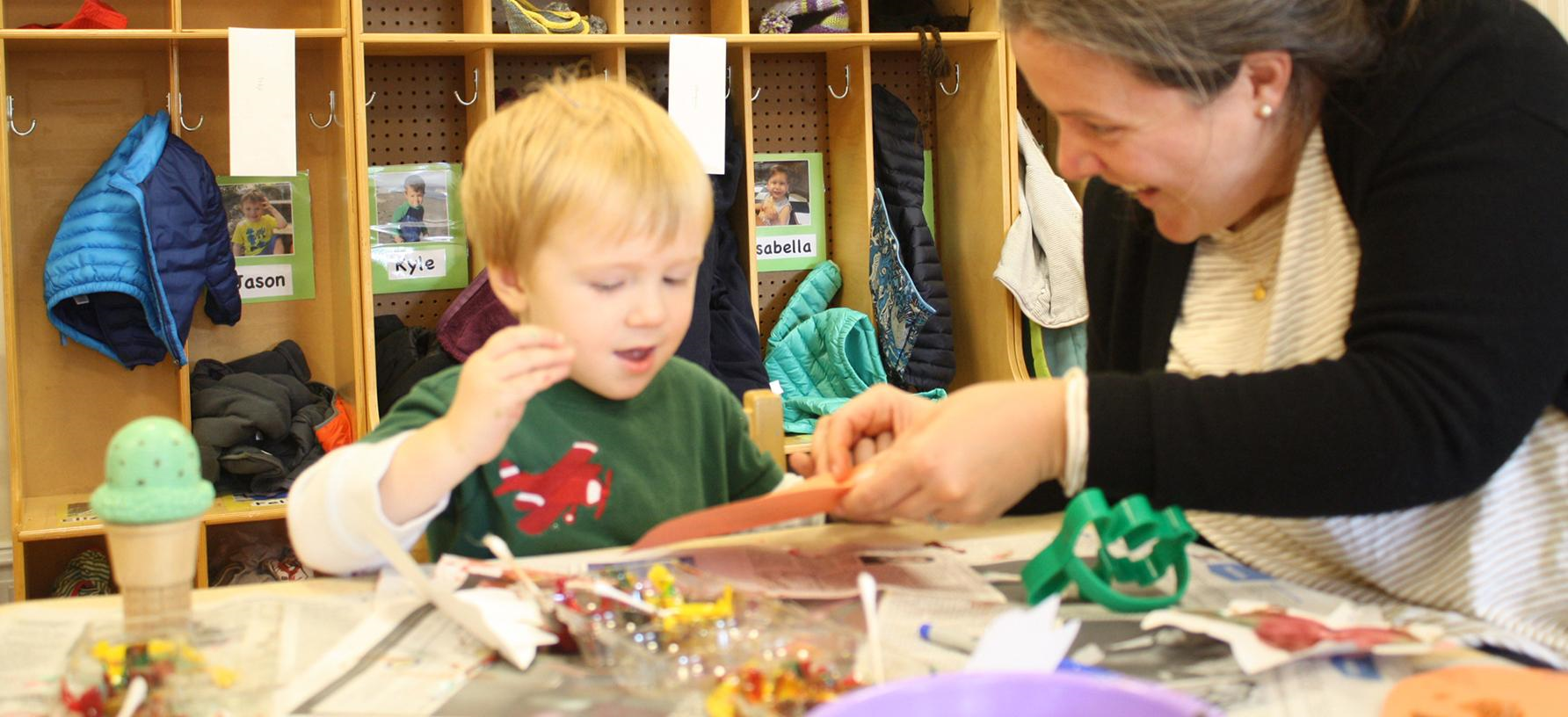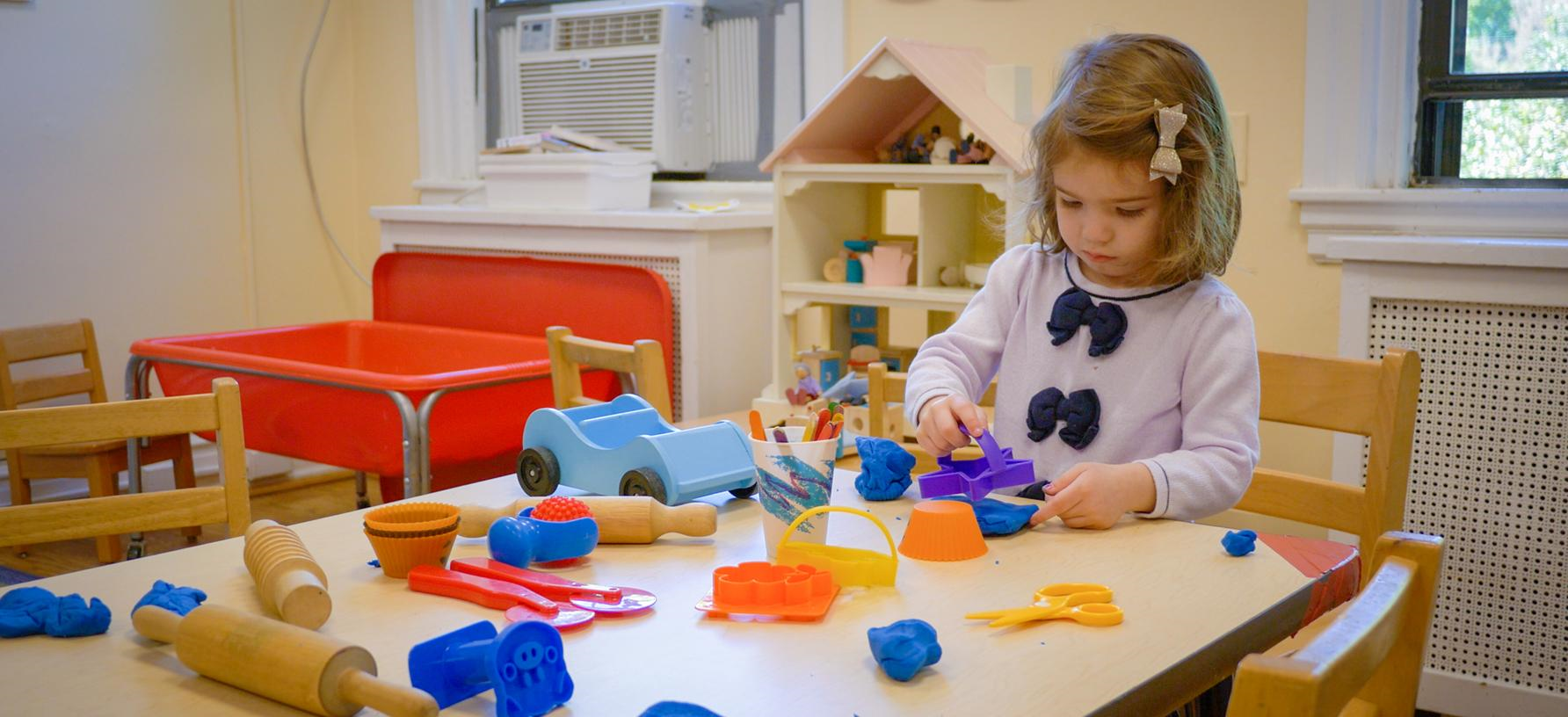A snow day at the Phoebe Anna Thorne School
By Amana Abdurrezak
8:00 a.m. – The Calm Before the Storm
Early-bird parents, many who drop off their kids on their way to work, enter the Phoebe Anna Thorne School in the morning with a sigh of relief. Unlike the chilly air and silvery clouds that have enveloped the air outside, inside the school is a warm and colorful cocoon.
With hues of red and yellow, the entrance resembles an L shape: At the shorter end, some parents greet the teachers who oversee the kids’ day of play. At the longer end, others chat and examine the row of picture books that sit atop a long bookshelf.
Thorne School parents can find informational material about play-based learning and logistics at eye level regardless of where they stand. But three-feet below rows of flyers, the kids that trot in the entrance gravitate towards the whiteboard nestled outside of the pre-K classroom. It hints at the day ahead in different shades of purple marker.
It’s Thursday: Water beads, Pumpkin bars, Snow?!?
***
The Method Behind the Madness
The Phoebe Anna Thorne School, located on both Bryn Mawr College and Haverford College’s campuses, is an untraditional option for parents thinking about early education programs. The school is modeled around the philosophy of “play-based learning” and has kindergarten, toddler, preschool, language-enrichment and early-intervention programs.

“We focus on child development as opposed to academics,” says Amanda Ulrich, the director of the Thorne School, “We think about each individual child and what their needs are whereas a lot of other schools stick with a curriculum.”
Ulrich is normally hustling around the floor, especially on late-minute snow days when kids need to go home early. In her calf-high boots, black leggings, and jersey-shirt-and-cardigan combo, she is answering questions from kids, figuring out logistics with teachers, and answering phone calls from parents.
You won’t find her wearing a hat, but she wears many of them as the director of the small operation. Her roles range from admissions and supervising the staff, to making sure there’s enough toilet paper in the bathroom and the kids get home safely.
Managing administrative work and budgeting are challenges, but she thoroughly enjoys her job and the mission of the school.
“The philosophy is rewarding because it’s organic and you see growth in ways that aren’t forced. Different kids have different experiences and you get to see them flower and bloom in different ways,” says Ulrich while keeping an eye on a boy who is anxious to get a glance at the snow.
***
9:30 a.m. – The Jury’s Verdict
In the Pre-K classroom, a jumbo paper turkey hangs from the ceiling with the body in the shape of a slightly-burnt omelet. It revolves on a string to show off its finger-painted “feathers” in different shades of green, red, yellow, blue, and orange. The few kids who gravitate towards a quieter playtime come in and plop down on the tiny chairs whose wooden seats look like xylophones. While they play with game pieces or toys laid out on the hexagonal tables, the crooked googly eyes of the turkey watch over them, a silent spectator.
In the Pre-K playroom, a group of kids sits around a castle playhouse and negotiate which doll should be thrown in jail.
“How about the witch?!” exclaims Emily, after raising a figurine with a black cape and hat in the air.
They quickly agree and open the sliding door to the dungeon. With little mercy, they shove the witch headfirst into the dungeon and slam the plastic gate. The group laughs and continues playing with the figurines who were deemed innocent.

10:00 a.m. – The Fire Squad Arrives
“The cubby is on fire!” yells Michael while fashioned in a fireman’s costume. His entourage consists of Jim, dressed in a crossing guard uniform, and Frank, dressed as a park ranger. Both diligently follow Michael’s lead: Frank bolts across the room as he yells into a fake walkie-talkie and Michael drives the toy firetruck across the room.
“Whooooooooooosh!” Michael sprays the cubbies with a green garden hose in hand. The three boys nod at each other in approval after deeming the fire is under control. They retreat back to their station.
The Thorne School’s play-based spaces provide kids with the toys and freedom to learn how to collaborate within the realm of their own imagination. One of the Thorne School’s teachers, Jodie Baird, enjoys fostering collaboration in the little worlds the preschool kids create every day.
“Children get to try out a lot of different ideas through play, they can work through emotions,” says Baird, “It’s also a great breathing ground for social interaction.”
In traditional early education classrooms, students may be more focused on academics: working on a letter of the day, engaging with books, practicing writing and more. Rather than disregard the importance of academics, the Throne School aims to build environments where students get to practice social and emotional skills on top of the academics.
For her preschoolers, Baird especially sees the play-based structure pay off as the school year progresses.
“They start the year playing, but all playing independently in parallel,” she says, “and what happens is a real social awakening where they see each other as potential playmates.”
In the middle of the playroom, Jim the crossing guard is off duty from the fire station and is playing doctor with a stuffed cow. Holding the toy carefully in his hands, he tries to quietly listen for a heartbeat with a plastic stethoscope. After only setting it down for a moment, his stethoscope is snatched away by a boy named Patrick.
Playtime leads to collaboration, but Baird is no stranger to having to teach her kids the difficulty of negotiation. “There’s much more room in a play-based scenario to learn the skills of conflict resolution, of perspective taking.”
Baird swoops in to settle rising tension between Jim and Patrick. Bending down to their level, Baird reminds Patrick to ask Jim for permission but also reminds Jim to share the toys with everyone in the class. Both sit quietly and sulk but nod their heads and move on.
After a minute, Jim decides that his cow is alive and well, leaving the stethoscope alone on the floor.
***
Learning Goes Both Ways
The Thorne School’s activities consist of more than just play from morning until the afternoon. Play sessions are separated by typical early education activities: story time, snack time, and activities developed by the teachers.
“Today, for example, we’re making handprint turkeys because that’s an iconic Thanksgiving activity and we’re reading a book about Thanksgiving, too,” says Baird.
Much of the curricula the teachers develop are a reflection of the kids’ interaction with the world around them. “On our sensory table, I put plastic snowflakes because we’re expecting snow today.”
The books students read at story time are also carefully chosen to reflect the environment or problems that arise in interactions in class.
“As the weather changes, we choose books that reflect the changing seasons,” says Baird, “Or as a holiday approaches, we select crafts and books that celebrate or reflect on that holiday.”
Regardless of the activity or type of day the teachers are running, Baird’s aim is to build trusting relationships with each of her students. Each morning as the students come in, she greets them by name at the door.
“What I hope that they get from me is a very consistent caregiver. School is kind of the same every day, and that’s very reassuring for a three-year-old who has so little control over their general life.”
“They can come to school and they know exactly what to expect. My behavior with them is the same every day, and they can trust that even if they do something that is a mistake or if they have an angry emotion, that I will still love them and accept them for who they are.”
For Baird, she finds this type of teaching to be incredibly rewarding—but she often finds herself learning from the kids as well.
“I say this to the children all the time: everyone is learning and growing. People make mistakes, but we can fix our mistakes. That is why we come to school.”
“I also see in children every day that they experience big feelings, anger, sadness, pain. But those feelings are just feelings—and they’re going to go away. I think being around that helps me remember that my feelings will come and go. That’s something I’m teaching to them and something I’m reflecting back on for myself.”
***
11:00 a.m. – Surprise Questions
The Thorne school is a snow globe by the time the district decides to cut school short. In the Pre-K room, some of the kids squish together on the rose-colored couch to share a picture book.
While their parents are making arrangements to pick them up, they’re unaffected by the logistical mayhem that comes from snow days. Instead, they enjoy spending time together while snow flurries gently fall outside.
For a 25-year veteran teacher like Kirsten Mudd, overseeing the kids’ growth and interactions is fruitful—and it has its amusing moments too. Teaching preschoolers and kindergartners sometimes requires answering simple questions like ‘where is my jacket?’ to bigger philosophical questions that take people by surprise.
“The big questions that we get are really interesting and funny because they’re about God and death. They’re starting to realize that their parents are not all-powerful,” she says.
“And I think it’s really funny when kids say, ‘I believe in God, but my parents don’t.’” she says with a chuckle.
In the play-based environment, these kinds of questions aren’t uncommon. Kids have a tendency to bump into each other during playtime and grapple with some of these themes through innocent play.
“Death is a huge one, particularly for preschoolers coming into the Pre-K class. They’re just learning what it is, but they don’t really understand it,” Mudd says, “They’ll offer you a cake, say, ‘it’s poison!’, and then bring you back to life. So, they don’t get it, but they are kind of getting it,” she says.
Some kids learn to grapple with big questions through play, even if they don’t get concrete answers. For others, they’re learning to become comfortable with their own authority.
“Some of them come in with a big voice and they know what they want, but they need to listen to other people.”
“And some of them come in without their own voice, so it’s rewarding if by the end of the year to sort of feel like they’ve made headway in whatever direction it was that they needed.”
Ultimately, the goal of the Phoebe Anna Thorne School is to let kids grow organically and learn to work through problems that they individually are prepared to tackle.
“Really, kids are working so many things out through play. They tend to choose what they are working on.”
“It just all sort of happens through play naturally and that’s the beauty of it. It’s right at their level—you’re not picking something that you think they should have. It just happens organically.”
Note:The names of children mentioned in this piece have been replaced with pseudonyms for their privacy and security. Photos are from the Phoebe Anna Thorn School.
